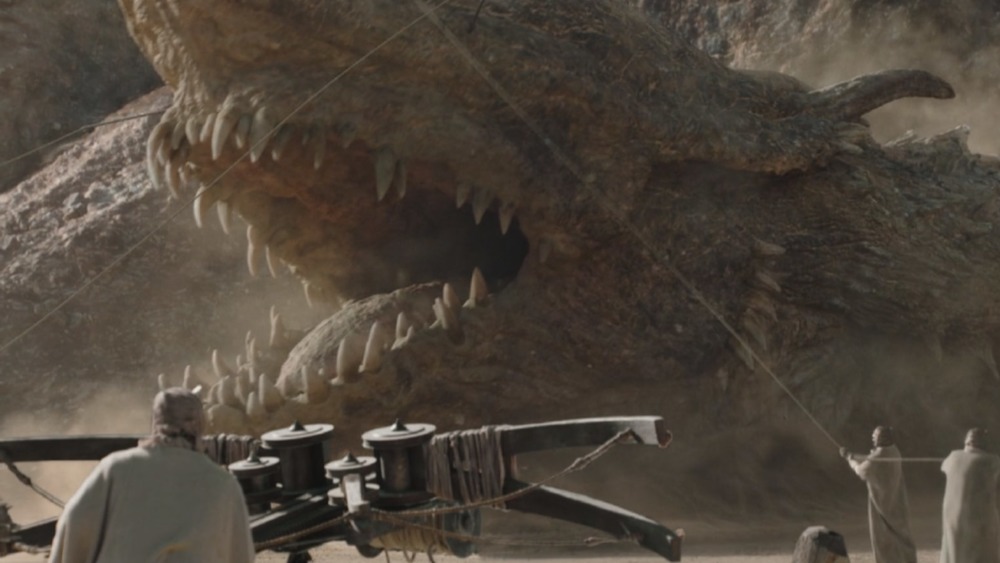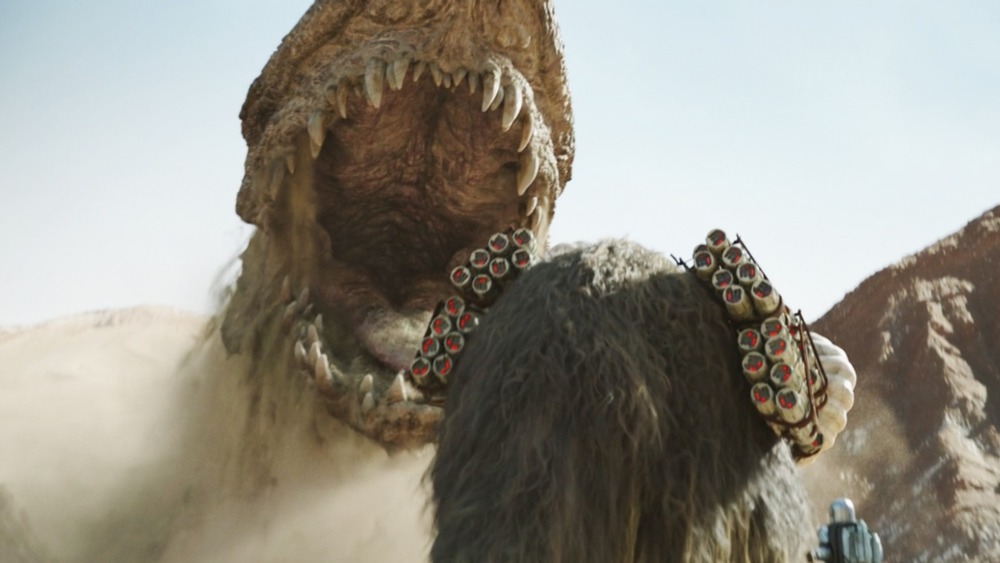Why The Mandalorian's Greater Krayt Dragon Doesn't Make Sense
When it debuted on Disney+ on October 30, 2020, season 2 of The Mandalorian wasted little time making waves yet again amongst Star Wars die-hards and casual Baby Yoda lovers alike. Only three episodes into its second season as of this writing, the series continues its tradition of telling a wholly unique and interesting story away from the Skywalker Saga while still finding room to give prior media a nod. Whether it's one of the program's many Easter eggs or a major plot point that dates back to before The Mandalorian was around, the showrunners make very deep cuts into the Star Wars canon. A prime example of this comes in the form of the legendary Greater Krayt Dragon that arrived in "Chapter 9: The Marshal."
A carnivorous serpent that looks like the distant cousin of Dune's sandworms, Tatooine's Krayt Dragon is one of Star Wars' oldest yet least-explored beasts. First appearing as nothing more than a weathered skeleton in 1977's A New Hope, the Krayt Dragon has spurred fans, authors, and video game developers to come up with their own interpretations of it over the years since a live specimen was previously unseen until The Mandalorian unveiled it in all its scaly glory. As a result, this is arguably the definitive interpretation of the Krayt Dragon — for the time being.
Even still, just because it's what the folks at Lucasfilm deemed accurate doesn't necessarily mean it applies to real-world scientific conventions, making the Krayt Dragon's physical appearance in The Mandalorian a bit confusing from an evolutionary standpoint.
The science behind the Greater Krayt Dragon doesn't check out
The big point of contention surrounding the Greater Krayt Dragon lies in its anatomy, which, by all accounts, shouldn't allow it to live and maneuver the way it does in The Mandalorian. In a recent Forbes editorial, Kevin Anderton spoke to Ph.D. student Josh Mead — a specialist in ecology and evolutionary biology at the University of Texas at El Paso — who revealed some very interesting scientific discrepancies that poke a few holes in the logic behind the creature's very existence.
"The first thing I noticed is that the skin of the dragon seems to be covered in rough scales, large horns, and the teeth seem to stick out a great deal," Mead said, explaining that these physical features should actually work against the Krayt Dragon as it attempts to swim throughout the Dune Sea on Tatooine. He also mentioned that while the Krayt Dragon's head is shaped properly for its living conditions, "the mouth seems to stick out below the snout, which would result in a mouth full of sand as it moves forward."
Mead then explained how in the real world, sand-swimmers don't breathe in the same way as most animals on Earth: "When one of these species breathes, its method of ventilation is not simply expansion and contraction of the ribs as seen in most reptiles. Instead, their ventilation moves the underside of the animal to prevent the collapse of sand when breathing."
Of course, in noting this, Mead also debunked the Krayt Dragon's hunting habits — claiming that since the Mandalorian (Pedro Pascal), Cobb Vanth (Timothy Olyphant), and their companions can hear it snoring, "the dragon's breathing does not work like the sandfish and would most likely scare off potential prey."
Finally, Mead spoke about the final portion of "Chapter 9: The Marshal," during which the sand-faring reptile burrows through the side of a solid mountain with relative ease and in little time. He bluntly commented, "This goes against everything we know about sand-swimmers who prefer to live in finer sands."
Hopefully, those of you whose childhood fears from watching Tremors were reignited courtesy of the Greater Krayt Dragon's arrival can sleep a little easier knowing that the monster exists as pure fiction and couldn't possibly survive long in the real world with physical limitations.

